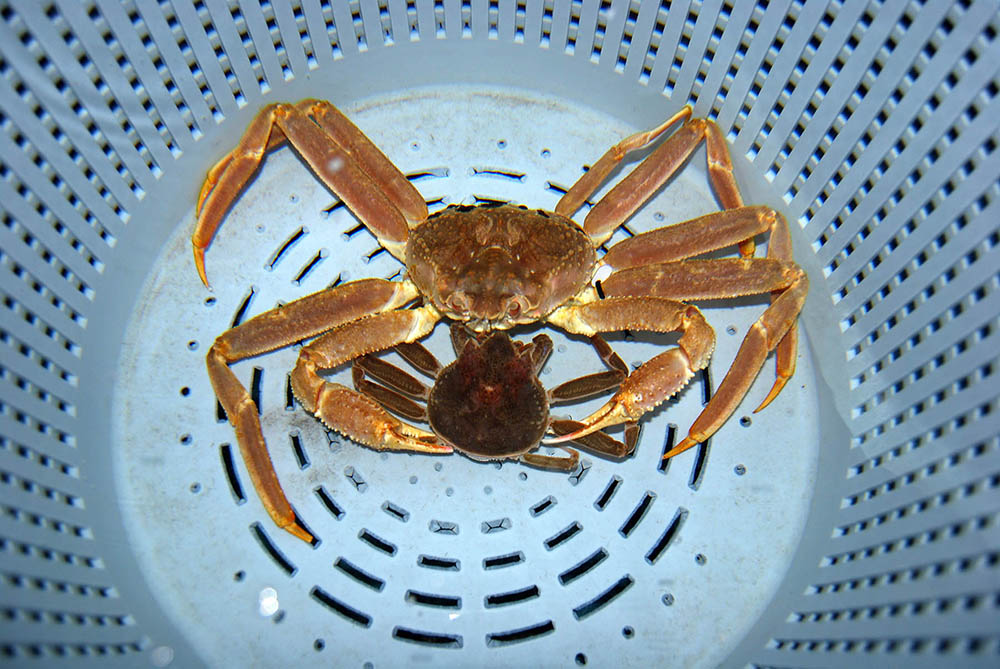
A NOAA Fisheries analysis, released Sept. 2, of the summer survey of Bering Sea crab stocks has concluded that in the wake of consecutive years of record warm temperatures, numbers of mature male and female snow crab are still down, but there’s a significant increase in immature snow crab abundance.
“Depending on how many of these young crabs actually survive to adulthood, this could be one bright spot for the fishing industry in a few years,” said Mike Litzow, survey lead and director of the Alaska Fisheries Science Center’s Kodiak Laboratory.
“We are providing these early results to stock assessment scientists and resource managers to inform science and management discussions that will occur over the next few months to identify fishery management measures for the 2023 fishing year,” Litzow said.
Last year’s survey, conducted as record warm waters continued, showed the lowest abundance of adult snow crabs and immature female crabs observed in nearly 50 years of NOAA Fisheries’ annual bottom trawl surveys of the Eastern Bering Sea.
NOAA uses data collected in this survey, plus data compiled by trained observers on commercial fishing vessels, and laboratory analysis of age and growth date, to estimate population abundance and sustainably manage commercial crab and groundfish species. The survey measures the crab abundance by weight in metric tons or metric tons caught.
The dramatic decline of snow crab, as well as Bristol Bay red king crab, is being studied by federal and state biologists. They have drawn no overall conclusions to date on the impact of ocean warming, ocean acidification and disease or groundfish commercial fisheries in these areas.
Snow crab rebuilding projections and other Bering Sea/Aleutian Island crab matters are on the agenda for the October meeting of the North Pacific Fishery Management Council in Anchorage.
Using data acquired in the latest survey, researchers estimated the mature male (20,403 mt) and female snow crab (20,941 mt) are 22% and 33% lower, respectively, than the numbers recorded in 2021. This is the lowest estimate in the time series for mature male abundance and third lowest for mature female abundance.
Researchers said this was not surprising, as it often takes several years to see population and ecosystem shifts after significant environmental events such as the heatwaves of 2016, 2018 and 2019 in the Bering Sea.
NOAA Fisheries has developed survey abundance estimates for the seven commercial crab stocks sampled in the survey, including snow crab, Bristol Bay red king crab, tanner crab, St. Matthew Island blue king crab, Pribilof Islands red king crab, Pribilof Islands blue king crab and Northern District red king crab.
Bristol Bay red king crab mature and immature male and female biomass estimates were higher than a year ago, although compared with historic values, male and female populations remain low across all size classes.
Estimated legal size male biomass was about 18,060 mt, which was higher than 2021, but less than the previous 20-year average of 27,106 mt. The majority of legal males were concentrated around central Bristol Bay and south to the Black Hills.
The 2022 estimated biomass of Tanner crab in waters east of 166° west generally increased, with the exception of mature females, but declined or remained constant in the west compared to last year.
Biomass estimates for legal male Tanner crab east of 166°, with shells wider than 120 mm, was about 6,450 mt. The 2022 estimated biomass of legal Tanner crab in the eastern sector was higher than in 2021, but still well below the previous 20-year average biomass of about 12,885 mt.
Estimated mature male biomass was 8,725 mt and the immature male biomass estimate was 6,036 mt. While mature and immature biomass estimates were up over 2021 values, they were still relatively low, researchers said.
St. Matthew Island blue king crab abundance estimates rose from 2021 estimates across all size and sex categories, data show.
The population of St. Matthew blue king crab has undergone three peaks in abundance and corresponding fishery openings and closures and has been closed since 2016. This year’s immature male biomass and abundance estimates were the highest they have been in a decade, although mature male estimates are depressed, the report said.
The Pribilof Islands red king crab estimated abundance for mature females declined, while estimated abundance for mature males rose moderately. Legal male biomass was about 5,075 mt, higher than in 2021, and similar to the previous 20-year average of some 4,982 mt.
Pribilof Islands blue king crab abundance remained low for males and females, Legal male crab biomass was estimated at 111 mt, which was below the estimated average of 270 mt for the previous 20 years.
Currently, there is no commercial fishery for Northern District red king crab. Survey results found the biomass estimate of legal-sized males, with shells larger than 135 mm, was 1,754 mt. The biomass estimates for mature and immature males were 2,335 mt and 423 mt, respectively.
